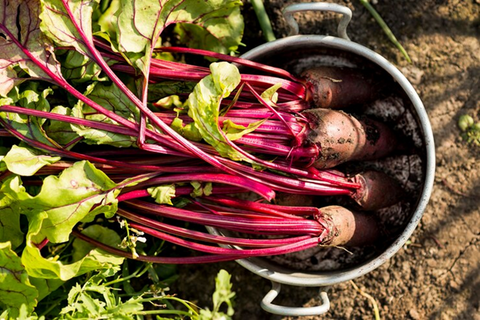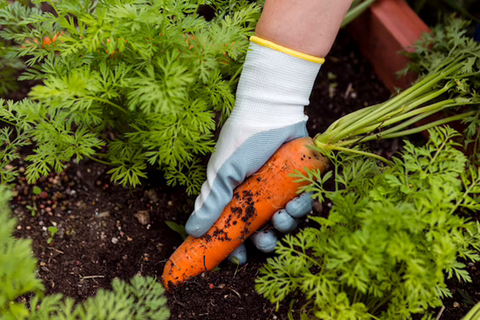Best vegetable crops for shade
When it comes to gardening in areas with limited sunlight, growing vegetables may seem like a daunting task. However, several crops thrive in the shade and can still provide a bountiful harvest. These "shade-tolerant" vegetables can be a great addition to any garden or balcony with less direct sunlight. So, if you're looking to add some variety to your garden, consider trying out the best vegetable crops for shade mentioned in this article
1. Which are the best vegetable crops for shade?
1.1 Lettuce
Buy now: The Rike Lettuce Seeds
Shade-grown lettuce is also an excellent option for gardeners with limited space or those looking to maximize their yields by growing multiple crops in the same area.
When it comes to growing lettuce in shade, there are a few key factors to consider. First, it's important to select lettuce varieties that are well-suited to low-light conditions. Some good options for shade include loose-leaf lettuce, butterhead lettuce, and oakleaf lettuce. These varieties tend to be more tolerant of heat and shade than other types of lettuce.
Another important consideration when growing lettuce in shade is soil quality. Lettuce requires rich, fertile soil that is well-draining and high in organic matter.
In terms of lighting requirements, lettuce typically needs about 6 hours of sunlight per day to grow properly. However, in shade conditions, this requirement may be lower. A good rule of thumb is to aim for about 4-5 hours of filtered sunlight per day.
1.2 Beetroot
Buy now: The Rike Beetroot Seeds

Beetroot (Beta vulgaris) is also one of the best vegetable crops for shade, as it can tolerate some amount of partial shade.
Beetroot is a cool-season crop that can be grown in the spring or fall. It prefers well-drained soil that is rich in organic matter. The soil should be moist, but not waterlogged. In partial shade conditions, the soil will tend to dry out less quickly than in the full sun, which can help to maintain the moisture level needed for successful growth.
In terms of light requirements, beetroot can tolerate up to 50% shade, which makes it an ideal crop for gardens that receive partial shade. In fact, in warmer climates, some gardeners will deliberately plant beetroot in the shade to help keep the soil cool and moist
1.3 Kale
Buy now: The Rike Kale Seeds
When it comes to finding the best vegetable crops for shade, we really can’t mention kale. Growing kale in the shade has several benefits. First, kale is a cool-season crop, and growing it in the shade can help to extend its growing season by keeping the soil cooler during the heat of summer. Second, kale is a leafy green vegetable that can be damaged by excessive exposure to sunlight, so growing it in the shade can help to protect it from sunburn and other types of damage.
To grow kale in the shade, it is important to choose a location that receives partial shade, such as under a tree. Kale can tolerate some direct sunlight, but too much can cause the leaves to become bitter and tough.
When planting kale in the shade, it is important to prepare the soil properly. Kale prefers well-drained soil that is rich in organic matter, so adding compost or other organic amendments to the soil can help to improve its texture and fertility.
1.4 Carrots
Buy now: The Rike Carrots Seeds

When planting carrots in shaded areas, it is important to select the right variety. Some carrot varieties are better suited for growing in shaded areas than others. For example, Nantes and Danvers are two varieties that can tolerate some shade and still produce good yields.
Another important consideration when growing carrots in shade are soil quality. Carrots prefer loose, well-drained soil that is rich in organic matter. In shaded areas, the soil can be more compact and have lower fertility, which can make it more challenging to grow carrots. To overcome this, adding organic matter such as compost or well-rotted manure to the soil can help improve its quality.
One of the benefits of growing carrots in shaded areas is that they are less likely to bolt or go to seed prematurely. This can be a problem in areas with full sun and high temperatures.
1.5 Celery
Buy now: The Rike Celery Seeds
Growing celery in shade conditions can help to reduce the risk of heat stress and sunburn, which can cause the plant to wilt, turn yellow, or develop brown spots on the leaves. It can also help to extend the growing season and improve the quality of the crop.
When growing celery in shade, it is important to select a location that receives partial shade or filtered light for at least 6 hours per day. This can be achieved by planting the crop under shade cloth, in a spot with a natural canopy of trees, or by growing it in the shade of taller crops such as corn or beans.
Celery is typically grown as a biennial crop, with seeds being sown in late winter or early spring and the plants being harvested in the summer or fall. It prefers a rich, well-draining soil that is high in organic matter and nitrogen, with a pH between 6.0 and 7.0. The plants should be watered regularly and fertilized with a balanced fertilizer throughout the growing season.
2. How do you grow vegetable crops for shade?

Finding the best vegetable crops for shade can be challenging, but growing them is even harder. However, it is possible with careful planning and execution. Here are some tips to help you grow vegetable crops for shade:
2.1 Choose the right location
Find a spot in your garden that receives partial shade for most of the day. This could be under a tree, next to a tall building or fence, or in a spot that receives filtered light through a shade of cloth. Make sure the soil is well-draining and rich in nutrients.
2.2 Prepare the soil
Add compost and other organic matter to the soil to improve its fertility and water-holding capacity. If the soil is heavy or compacted, consider raised beds or containers to improve drainage.
2.3 Provide shade
If your garden doesn't have a naturally shaded spot, you can create shade using shade cloth or other materials. You can also use trellises or other structures to provide shade for your crops.
2.4 Water regularly
Vegetables grown in shade require less water than those grown in full sun, but they still need regular watering to keep the soil moist.
2.5 Fertilize regularly
Since vegetable crops grown in shade receive less sunlight, they may require more fertilizer to grow properly. Use a balanced fertilizer that is rich in nitrogen, phosphorus, and potassium, and apply it according to the instructions on the package.
2.6 Monitor for pests and diseases
Vegetable crops are grown in shade may be more susceptible to pests and diseases, so it's important to monitor them regularly and take action if necessary.
3. Finally,
In summary, choosing the best vegetable crops for shade can be a great way to maximize your garden space and produce a healthy harvest. By selecting shade-tolerant varieties and providing the right growing conditions, you can enjoy a variety of fresh and delicious vegetables all season long. If you are looking for premium vegetable seeds, The Rike could be your perfect choice. Our main offerings include: hundreds of heirloom, rare and hard-to-find flower seeds, vegetable seeds, and herb seeds for both the home gardener and the wholesale trade.





Leave a comment